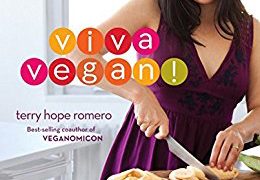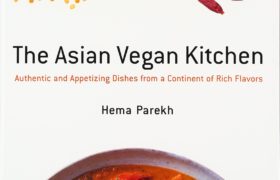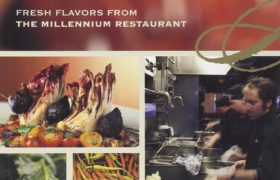For the month of September, this blog will be devoted to VeganMofo. Tune in while I provide short reviews of some of my favorite, and least favorite, vegan cookbooks.
Earlier this month, I described how Vegan with a Vengeance is the book I always recommend to new vegans. Veganomicon tends to be the book that everyone else recommends. It seems like a good candidate. It attempts to be a comprehensive work, with guides to all of the basics–steaming vegetables, cooking beans, cooking rice. The chapters cover tempeh and tofu, desserts and breakfast, soups and sandwiches. When Moskowitz and Romero wrote it, they intentionally designed it to be the source you turn to in times of vegan need.
I never recommend it because it just never became that source for me. I never found recipes in it, like the tempeh and white bean patty in Vegan with a Vengeance, that I turned to repeatedly. I tried! I really did! I wanted this book to be the last cookbook that I ever bought. Here’s an abbreviated list of the recipes I’ve tried;
Acorn squash, pear, and adzuki soup — I liked it, even if it was a bit sweet. Two different boyfriends vetoed it, though, so I only made it twice.
Pumpkin ziti with sage breadcrumbs — too sweet and underseasoned
Lemony roasted potatoes — Good, but they are basically just potatoes with lemon juice. I put it on the menu at my co-op and they never disappeared from the buffet as fast as normal roasted potatoes
Chickpea cutlets — The banner recipe of this book. Again, I had this on the co-op menu and it was not wanted back. it just didn’t have the same level of flavor as any decently made vegetable-based dish.
Cauliflower and mushroom potpie — Underseasoned! This is a theme with this book!
Leek and bean cassoulet — I made this one a few times because of an abundance of leeks from my CSA, but it is watery and underseasoned. Extremely comforting though, if you can eliminate most of the water.
For the most part, I just found them to be, as you can see above, underseasoned and occasionally, trying too hard. They attempted to represent a wide swath of traditional American cookery, especially comfort foods. Unfortunately, many of those comfort foods were comforting because of the large amounts of fat and sodium contributed by cheese and animal fat. Swapping out animal ingredients for vegan substitutes one for one is not usually as tasty a tactic as building delicious vegan meals with vegetables in mind from the start.
Thus, my copy of Veganomicon sank into disuse. I still feel guilt about it though. Aren’t I supposed to like it? There’s 250+ recipes–maybe the problems are localized to the 20 or so that I’ve tried? I could try again, but it’s hard when there are so many other cookbooks to try–like the one I will present tomorrow.





